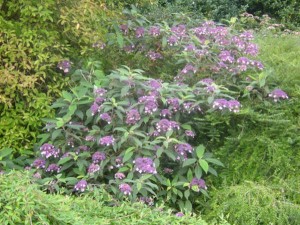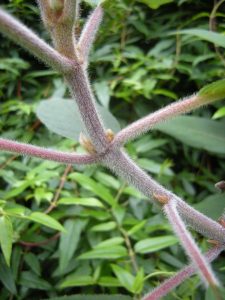Hydrangea aspera the young stems are frosted white with a covering of minute hairs. The bark on older wood becomes papery and peels from the stem. The deciduous leaves are felty to the touch with precision incisions to the edges and a white reverse.
In the borders above the fern house it grows in overhanging shade and flowers well as can be seen from the images. W.J. Bean in Trees and Shrubs Hardy in the British Isles describes the inflorescence as a flat topped or slightly convex cymose corymb. It is a very distinct colour in that the central mass of fertile flowers is almost at the blue spectrum of purple. The outer sterile ray flowers are pink.
Native to an area stretching from the Himalayas to Java. A worthwhile addition to a woodland garden for late summer colour.
We have Ernest Wilson to thank for the more vigorous sub species; Hydrangea aspera ssp. strigosa. He collected this in Hubei Province, China in 1907. His notes say thicket; which may refer to the habit of growth as the plant in the border has sent up a congestion of intermingled shoots which increase the size of its rootstock by continually sprouting new wood from the base. More vigorous and less showy than the species and with rougher hairs on the new growth.


